Knowledgeable’s Ranking
Execs
First rate performancePCIe 5.0 x2 or PCIe 4.0 x4Five-year guarantee and good TBW ranking
Cons
PCIe 5.0 efficiency was inconsistent and slower than PCIe 4.0 performancePricey in comparison with the discount PCIe 4.0 competitors
Our Verdict
Samsung’s 990 EVO can run on the PCIe 5.0 customary, however it’s constrained to 2 lanes (x2) and performs strictly like a PCIe 4.0 SSD. A considerably expensive, and never significantly quick PCIe 4.0 SSD, at that.
Worth When Reviewed
1TB: $125 I 2TB: $210
Finest Costs Immediately: Samsung 990 EVO
$124.99
Samsung is first to market with what would seem like the inexpensive PCIe 5.0 SSD we’ve all been ready for — the 990 EVO. Alas, in our testing, with the drive solely in a position to leverage two PCIe 5.0 lanes, it proved slower and fewer constant than when utilizing 4 lanes of PCIe 4.0. Even for PCIe 4.0, it’s not a very quick, and on the expensive aspect.
Additional studying: See our roundup of the most effective SSDs to study competing merchandise.
What are the Samsung 990 EVO’s options?
The 990 EVO is a 2280 type issue (22mm vast, 80mm lengthy) NVMe SSD using stacked, 133-layer TLC NAND and an in-house Samsung controller, based on the corporate.
Unusually, it will probably operate as both a four-lane (x4) PCIe 4.0 (or earlier generations at slower speeds), or a two-lane (x2) PCIe 5.0 M.2 SSD, offering the identical theoretical bandwidth. With the precise BIOS, it may save a few valuable PCIe 5.0 lanes in that mode. Credit score to Samsung for the innovation.
Host Reminiscence Buffer (HMB) is utilized for main caching so there’s no DRAM on board. Current classic HMB has confirmed equal or higher than DRAM-enabled PCIe 4.0 SSDs in sustained transfers, and nearly as quick general as DRAM-endowed PCIe 5.0 designs.
Notice that that is the primary HMB/PCIe 5.0 SSD we’ve seen or examined.
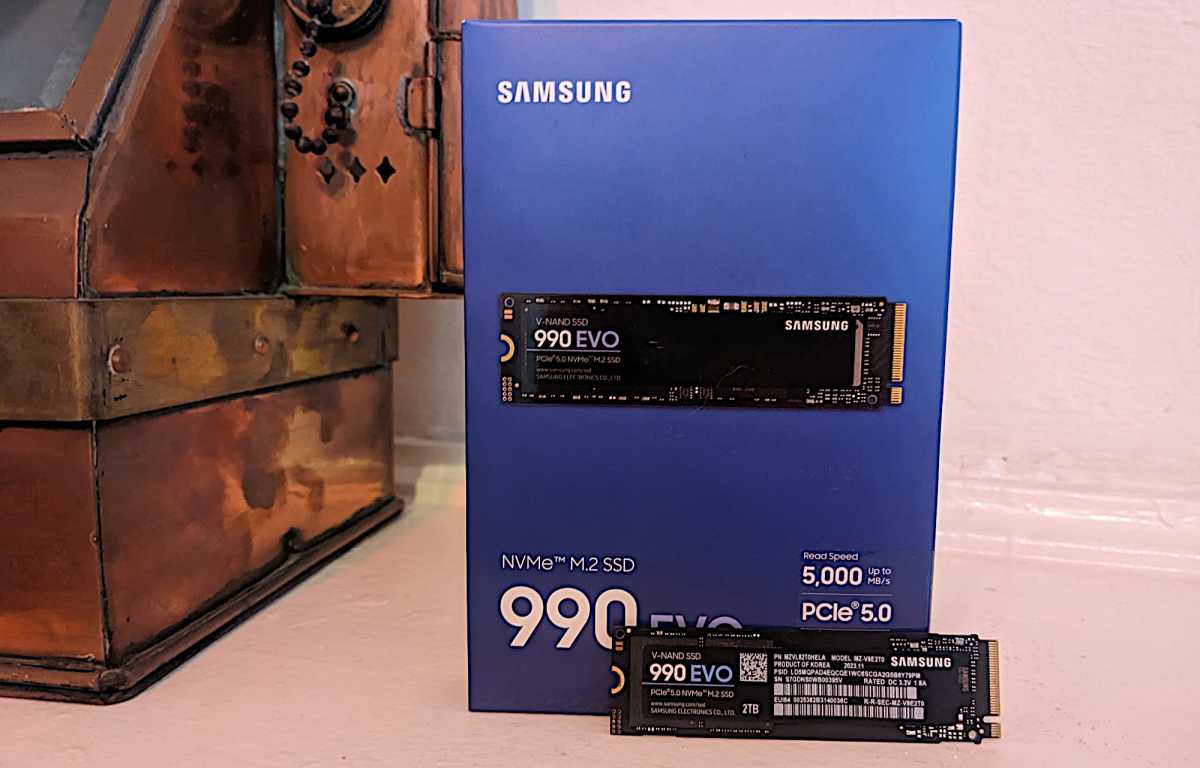
The 990 EVO is warrantied for 5 years or 600TBW (terabytes that could be written) per 1TB of capability. That guarantee is par for the course, as is the TBW ranking. Hardly Seagate-like, however significantly better than QLC NAND drives.
How a lot is the Samsung 990 EVO?
The 990 EVO will ship in 1TB and 2TB flavors for $125 and $210, respectively. That’s the MSRP and practically twice what you’ll pay for a discount HMB PCIe 4.0 NVMe SSD.
For a model with the cachet and fame of Samsung, the premium pricing is considerably comprehensible. But in addition know that whereas the 990 EVO helps PCIe 5.0, it’s no sooner than the typical PCIe 4.0. As you’ll see under.
How briskly is the Samsung 990 EVO?
The 2TB 990 EVO that Samsung despatched us proved a decidedly unspectacular performer. It’s by far the slowest PCIe 5.0 SSD we’ve examined, and whether or not PCIe 5.0 or 4.0 was utilized, it solely hit the PCIe 4.0 common. However the principle difficulty was that the PCIe 5.0 CrystalDiskMark 8 numbers had been wildly inconsistent throughout runs — wherever from 3GBps to 5GBps studying. Regular variation is a pair hundred MBps max.
The inconsistency triggered us to throttle our testbed’s PCIe M.2 slots to 4.0 and retest. The CrystalDiskMark 8 and AS SSD 2.0 (not proven) outcomes when utilizing the 990 EVO over PCIe 4.0 had been barely sooner to a lot sooner, and completely constant throughout runs — roughly 5GBps studying and 4GBps writing sequentially in CrystalDiskMark.
Fairly possible, HMB, at the very least as carried out on the 990 EVO, likes extra pipes, even when they’re solely half as quick.
Consider the 990 EVO as a barely expensive, average-performing PCIe 4.0 SSD.
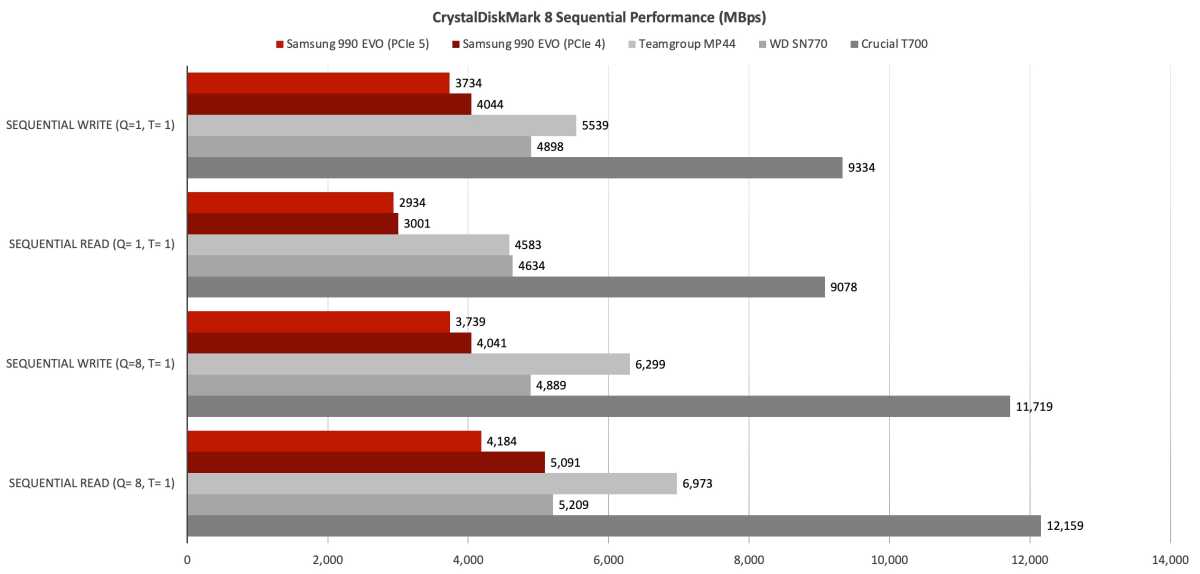
Notice that the competing Teamgroup MP44 and WD SN770 are each PCIe 4.0 HMB designs. The Essential T700 is thrown in to offer you an concept of what’s attainable with PCIe 5.0 (and DRAM).
The 990 EVO’s 4K efficiency (proven under) below CrystalDiskMark 8 was much more aggressive.

Our real-world sequential 48GB switch exams had been kinder to the 990 EVO than CrystalDiskMark 8 — at the very least whereas secondary cache (TLC written as SLC) held out. In truth, it beat out the primary general Essential T700 — a drive that had a mysteriously onerous time studying smaller information and folders whereas developing aces at every little thing else.
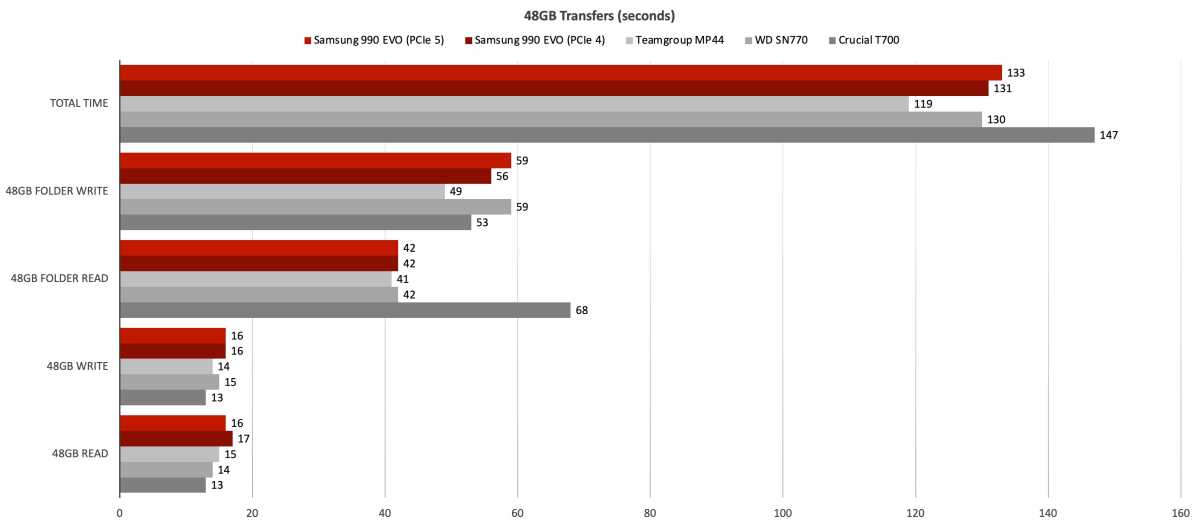
Secondary cache ran out simply previous the 100GB mark, therefore the 5 minutes plus it took the 990 EVO to write down the complete 450GB. You may see the precise prevalence within the final picture under.
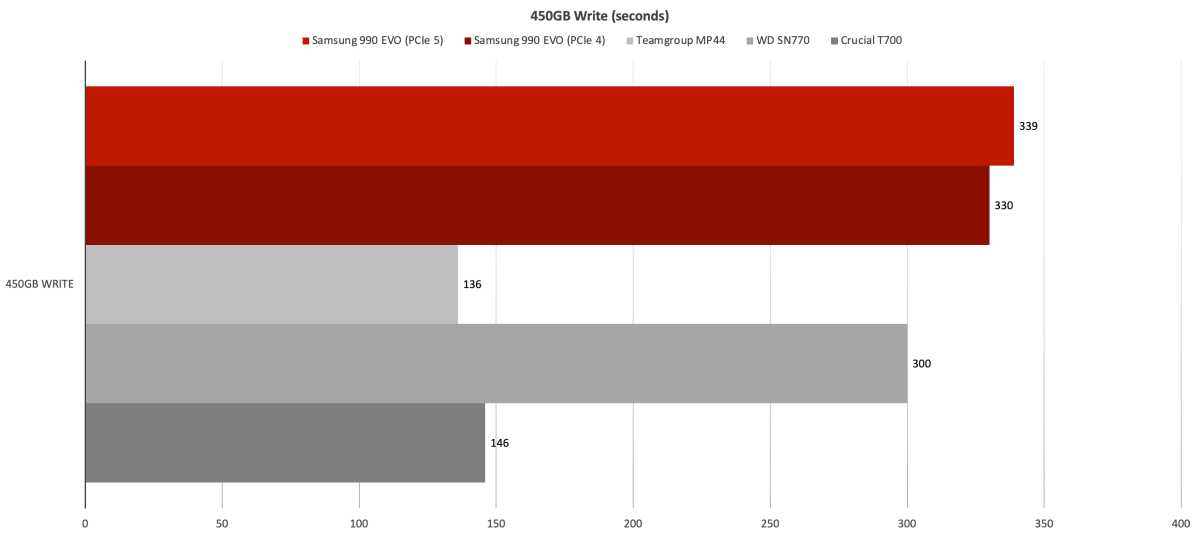
Whereas the 990 EVO writes to secondary cache at over 3GBps, it drops to round 1.15GBps when writing natively to the TLC NAND. That’s really not that dangerous contemplating onerous drives handle solely 250MBps and SATA SSDs prime out at 525MBps. It’s not ideally suited, however it’s not the tragic-for-NVMe 150MBps you’ll see when some QLC drives run out of secondary cache.
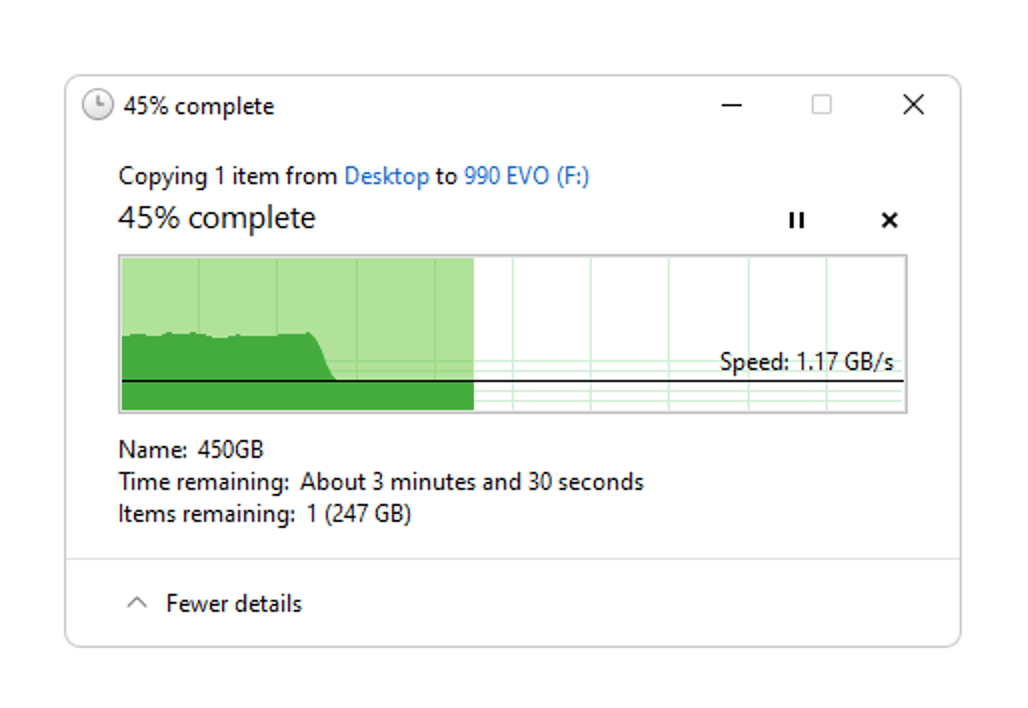
Notice that the PCIe 5.0 points could also be associated to our testbed and never impact different computer systems. The complete testbed configuration could be discovered on the finish of the article. The motherboard is an Asus ROG STRIX Z790-i. We paid onerous money for it so we don’t usually give the corporate free promoting, however on this case the make and mannequin may be related.
Do you have to purchase the Samsung 990 EVO?
The 990 EVO was a sooner, extra constant performer with 4 lanes of PCIe 4.0 than with two lanes of PCIe 5.0. Why, we’re not sure; nevertheless, neglect the PCIe 5.0, modern as it’s, and consider it as a barely expensive, average-performing PCIe 4.0 SSD and make you resolution from there.
Sadly, the discount PCIe 5.0 SSD stays a chimera.
How we check
Drive exams at the moment make the most of Home windows 11 (22H2) 64-bit operating on an X790 (PCIe 5.0) motherboard/i5-12400 CPU combo with two Kingston Fury 32GB DDR5 modules (64GB of reminiscence complete). Intel built-in graphics are used. The 48GB switch exams make the most of an ImDisk RAM disk taking on 58GB of the 64GB complete reminiscence. The 450GB file is transferred from a Samsung 990 Professional 2TB, which additionally comprises the working system.
Every check is carried out on a newly formatted and TRIM’d drive so the outcomes are optimum. Notice that as any drive fills up, efficiency will lower as a result of much less NAND for secondary caching, and different elements.
The efficiency numbers proven apply solely to the drive we had been shipped in addition to the capability examined. SSD efficiency can differ by capability as a result of extra or fewer chips to learn/write throughout and the quantity of NAND out there for secondary caching (writing TLC/QLC as SLC). Distributors additionally often swap elements. When you ever discover a big discrepancy between the efficiency you expertise and that which we report (programs being roughly equal), by all means—tell us.
